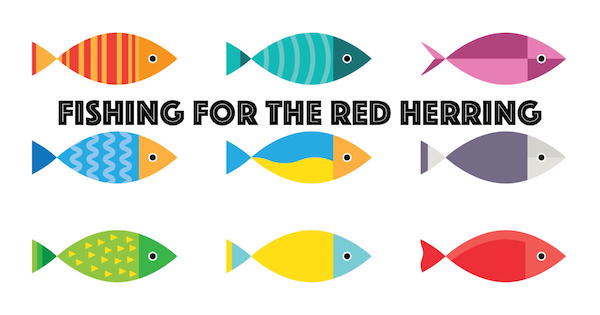
The herring fish of Eugene Field’s poem “Winken, Blinken and Nod” was probably a special glittering creature, because the fishermen went after them with nets of silver and gold. Writers, on the other hand, are always interested in the infamous red herring. A device especially employed in mysteries, it can be used in other genres as well. What is a red herring and how can it be a helpful item on your authorial menu? Let’s take a look.
A false trail
A red herring is a falsely sowed clue, or a suspect who looks like a sure bet for the perpetrator but who really isn’t. Essentially, it’s a smelly bit of bait dragged across the bloodhound’s track to confuse his nose. The reveal at the end, when the innocence of our fish becomes apparent despite all the evidence to the contrary, is a great way to surprise and delight the reader, even those who think they can figure out the mystery in advance.
Picture an Agatha Christie novel, where there’s always a huge array of potential perps. All of them will have a motive. All of them will have the opportunity. There are some teeny tiny clues, but it’s a rare armchair detective who recognizes their importance until Inspector Poirot tells us at the end. Those clues are out there, nonetheless—we see them, without realizing their significance, right from the start. They’re like the seven doors in Bluebeard’s castle. Some of them are important, some of them will lead us astray. We don’t know which until the conclusion.
The early bird gets the herring
Salt your herrings early. Leave subtle clues from the very beginning—the timing on this is important. Before you have a favored suspect is the time to salt deceptive clues for the future; afterwards they become too obvious. An editor once explained it to me this way: mention early on that there is a letter jacket hanging in Joe’s closet. By itself it will mean nothing to the reader, and she’ll probably forget all about it, until she realizes it was significant all along. But once you’ve gotten as far as figuring out the criminal was a football player, it’s too late to introduce this fact. The clue would be too obvious. It would be like a big tattoo across Joe’s face saying “guilty.”
Now imagine the letter jacket in Joe’s closet turns out to belong to his roommate. We shouldn’t find that out until just before the end, because up to now we’ve been sure Joe is the culprit. The jacket is a red herring, making us think one thing, when another turns out to be true. The herring is salted, and the reader has taken the bait. But keep it subtle.
Not just in whodunnits
Undercutting expectations is a great way to freshen up a story, no matter its genre. Think of how Dickens surprises us in A Tale of two Cities with the heroic generosity of Sydney, whom we’ve been led to believe is a vapid wastrel. How, in Harry Potter, Snape’s seeming act of treachery turns out to be obedience to Dumbledore’s will. And all that while we thought he was a villain.
It takes a little planning, but the old red herring will spice up your plot deliciously.

Teri Pizza
Thank you Niki for this article. I plan to use your hints and tips in my next book (or the one after that)!
I appreciate the time you took to help us other writers.
Niki Kantzios
We’re all in this together, Terri, and many heads are better than one. Write on!